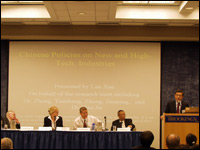Registration
You will receive an email confirming your registration.
IMGXYZ790IMGZYX On September 26, 2007, the Carnegie Endowment and the John L. Thornton China Center of the Brookings Institution co-sponsored a discussion of China’s increasingly high technology trade. The discussion centered on two questions: First, how high – and how fast – is China’s trade moving up the technology ladder? Second, what are the causes and policy implications for China and the U.S. of China’s increasing export sophistication? Featured speakers included Jiyao BI, National Development and Reform Commission (Beijing); Zhi WANG, U.S. International Trade Commission; and Lan XUE, Tsinghua University, Harvard University and the Brookings Institution. Ernest Preeg, Manufacturers Alliance, and Nicholas R. Lardy, Peterson Institute of International Economics, provided commentary. Carnegie’s Sandra Polaski moderated the event.
Jiyao Bi opened his remarks by noting that high-technology products are increasingly important in both China’s exports and imports. Despite this expansion in the trade of sophisticated goods, however, Dr. Bi asserted that China’s innovative capacity remains weak, and that the country is only slowly moving up the technology ladder. Foreign-invested firms account for over 90% of China’s high-tech exports, indicating that domestic companies have achieved much lesstechnological advancement. Research and development spending is low throughout the country, limiting future technological progress. Dr. Bi concluded by emphasizing that China is still a developing country on the road to industrialization, and has a long way to go to transform itself into a knowledge-based economy.
Zhi Wang presented the findings of a team of American and Chinese researchers studying U.S.-China trade in high-technology products. The group found that in 2006 the U.S. deficit in high-technology trade with China was around $45 billion. Dr. Wang highlighted three important characteristics of China’s high-tech exports to the U.S.: 95 percent are processing exports, 90 percent are produced by foreign-invested firms, and 65 percent are produced in government “policy zones” that provide incentives for favored types of production. Like Dr. Bi, he rejected the notion that China was quickly moving up the technology ladder and would soon compete with high-tech American manufactures. Citing in detail the very large differences between the unit value of Chinese and American high-tech exports even in the same tariff categories, Dr. Wang affirmed that a considerable quality and technological gap remained between the manufacturing industries of the two countries.
Next, Lan Xue provided an overview and assessment of Chinese policies related to high-technology exports. Since the 1980s, China has implemented a variety of policies aimed at attracting foreign investment and encouraging exports. In the 1990s, these policies were revised to more specifically target the promotion of high-tech industries. Dr. Xue noted that China had succeeded in increasing foreign investment and exports, however had not improved the innovative capabilities of domestic firms. More recently China has moved away from export promotion to a more trade-neutral stance, adopting policies aimed at curbing the country’s high-polluting, energy-intensive sectors and encouraging greater domestic investment in research and development and technological innovation. Although it is too soon to see the full effects of these policies, Dr. Xue predicted that over time they would gradually reduce exports and help develop domestic equipment manufacturing enterprises.
In his commentary Ernest Preeg remarked that he disliked the distinction between “processing” and “normal” exports. Due to the increasing international fragmentation of the production process, he explained, processing has today become the normal form of export production, something which is true both in developed and developing countries. He also expressed a fear that China was moving toward a more nationalist economic policy which favored domestic firms over foreign firms. He believed this would have a negative impact on both U.S. firms and on China, which would lose international investment to other countries such as India. Finally, Dr. Preeg asked the panel if they had accurate data on how much value-added China contributed to its exports. He put the figure roughly in the area of 60 to 70 percent, which is comparable to that of the United States and significantly higher than many other researchers believe it to be.
Nicholas R. Lardy strongly disagreed with Dr. Preeg’s contention that China contributed up to 70 percent of the value added of its exports and was moving up the technology ladder. Dr. Lardy suggested Chinese value added was approximately 35 percent, and had not significantly increased over the past 10 years. He also asserted that data on China’s trade in high-tech products revealed nothing about China’s domestic technological sophistication, as the industry is dominated by the processing trade and foreign-invested firms. According to Dr. Lardy, China’s move into high-technology exports has no implications for American sophisticated manufactures or innovation.
During the subsequent question and answer period, the panelists were asked whether some of China’s policies to encourage technological development – most notably a 150 percent tax deduction for R&D spending – were WTO-compliant. Dr. Xue and Dr. Bi agreed that since China’s policies provided the same benefits to domestic and foreign-owned enterprises they would be considered WTO-compliant. In response to Dr. Preeg’s fear that China might be adopting nationalist economic policies, Dr. Xue stated that the Chinese government had expressed a desire to improve domestic high-tech capabilities, but asserted that none of the recently adopted policies were nationalist. Concerning the issue of China’s domestic value added, Dr. Wang commented that it was a hotly debated topic among researchers, and that different methodologies for calculating value added produced vastly different estimates.
